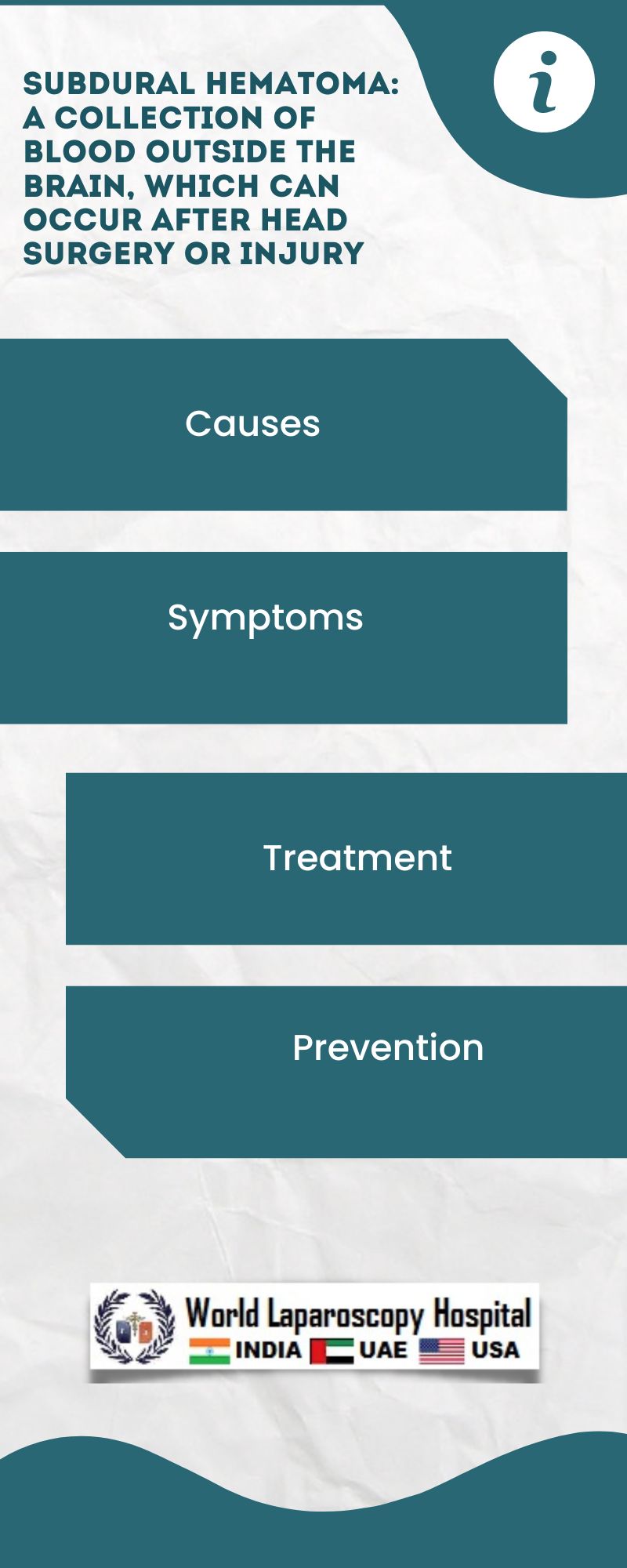Subdural hematoma: A collection of blood outside the brain, which can occur after head surgery or injury
Introduction
Subdural hematoma is a critical medical condition characterized by the accumulation of blood outside the brain, typically beneath the dura mater, the brain's outermost protective membrane. This condition can result from head injuries, surgeries, or even seemingly minor trauma. Understanding its causes, symptoms, diagnosis, and treatment is crucial for timely intervention and improved outcomes.

Causes and Risk Factors
Subdural hematoma occurs when blood vessels between the brain and its outermost covering, the dura mater, rupture and bleed. The accumulation of blood puts pressure on the brain, potentially causing damage. This condition can result from various factors, including:
Head Trauma:
A significant impact to the head, such as from a fall, motor vehicle accident, or assault, can lead to subdural hematoma. Even minor head injuries can occasionally cause this condition, particularly in individuals with underlying brain atrophy or a history of repeated head trauma.
Older Age:
As people age, their brain shrinks and the bridging veins that run between the brain and the dura mater become more susceptible to tearing. This increases the risk of subdural hematoma, especially in older adults.
Blood-Thinning Medications:
Certain medications, such as anticoagulants (e.g., warfarin, aspirin) and antiplatelet drugs (e.g., clopidogrel), can increase the risk of bleeding and contribute to subdural hematoma formation.
Alcohol Abuse:
Chronic alcohol consumption can lead to brain atrophy and an increased risk of falls and head injuries, which in turn can raise the likelihood of subdural hematoma.
Medical Conditions:
Certain medical conditions, such as liver disease, which can impair the body's ability to form clotting factors, may increase the risk of subdural hematoma.
Symptoms and Diagnosis
Symptoms of subdural hematoma can vary depending on the size and rate of bleeding, as well as the individual's age and overall health. Common symptoms include:
- Headache: Often severe and persistent, especially following a head injury.
- Confusion: Difficulty remembering recent events or processing information.
- Nausea and Vomiting: May occur due to increased pressure on the brain.
- Weakness or Numbness: Typically on one side of the body.
- Difficulty Speaking: Slurred speech or difficulty finding the right words.
- Seizures: May occur in some cases.
Diagnosing subdural hematoma often involves a combination of imaging tests and a detailed medical history. CT scans and MRI scans are commonly used to visualize the brain and detect the presence of blood outside the brain.
Treatment and Management
The treatment of subdural hematoma depends on its size, symptoms, and the patient's overall health. Options include:
Observation:
Small hematomas without significant symptoms may be monitored closely, especially in patients with a higher risk of complications from surgery.
Medication:
In cases where the hematoma is small and not causing significant symptoms, medications may be used to manage symptoms and prevent further clotting.
Surgery:
For larger hematomas or those causing severe symptoms, surgical intervention may be necessary. Surgery typically involves draining the accumulated blood and, if necessary, repairing the underlying cause of the bleeding.
Prevention
Preventing subdural hematoma is largely centered around reducing the risk of head injuries, especially in older adults and those taking blood-thinning medications. Simple precautions, such as wearing seat belts in cars, using helmets when biking or participating in contact sports, and installing handrails in homes, can help prevent falls and reduce the risk of head trauma.
Conclusion
Subdural hematoma is a serious condition that requires prompt medical attention. Understanding its causes, symptoms, diagnosis, and treatment options is crucial for timely intervention and improved outcomes. By taking preventive measures and seeking medical help when necessary, the risk of subdural hematoma can be minimized, leading to better overall brain health and well-being.
| Older Post | Home | Newer Post |





